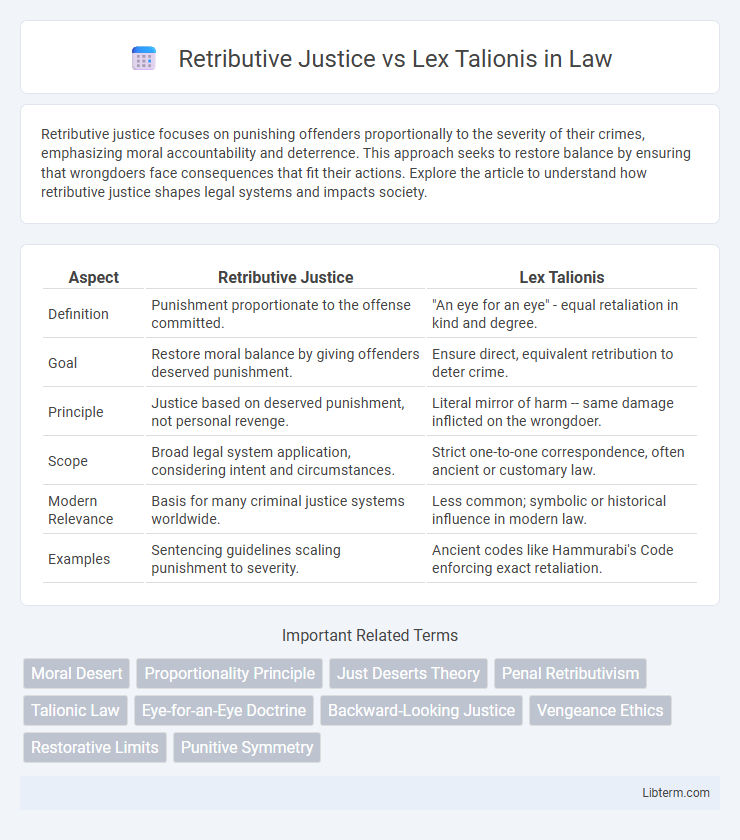Retributive justice focuses on punishing offenders proportionally to the severity of their crimes, emphasizing moral accountability and deterrence. This approach seeks to restore balance by ensuring that wrongdoers face consequences that fit their actions. Explore the article to understand how retributive justice shapes legal systems and impacts society.
Table of Comparison
| Aspect | Retributive Justice | Lex Talionis |
|---|---|---|
| Definition | Punishment proportionate to the offense committed. | "An eye for an eye" - equal retaliation in kind and degree. |
| Goal | Restore moral balance by giving offenders deserved punishment. | Ensure direct, equivalent retribution to deter crime. |
| Principle | Justice based on deserved punishment, not personal revenge. | Literal mirror of harm -- same damage inflicted on the wrongdoer. |
| Scope | Broad legal system application, considering intent and circumstances. | Strict one-to-one correspondence, often ancient or customary law. |
| Modern Relevance | Basis for many criminal justice systems worldwide. | Less common; symbolic or historical influence in modern law. |
| Examples | Sentencing guidelines scaling punishment to severity. | Ancient codes like Hammurabi's Code enforcing exact retaliation. |
Introduction to Retributive Justice and Lex Talionis
Retributive justice is a legal philosophy centered on proportionate punishment, asserting that offenders deserve consequences commensurate with the harm caused. Lex Talionis, often summarized as "an eye for an eye," is an ancient principle of retributive justice emphasizing reciprocal punishment equal to the offense committed. The distinction lies in retributive justice's broader ethical framework, while Lex Talionis represents a specific, literal application of proportional retaliation.
Historical Origins of Lex Talionis
Lex Talionis, often summarized as "an eye for an eye," originates from ancient Mesopotamian law codes such as the Code of Hammurabi, dating back to around 1754 BCE. This principle established a direct correlation between the punishment and the offense, aiming to ensure proportional justice and deter excessive retribution. In contrast to broader retributive justice that encompasses moral and societal considerations, Lex Talionis strictly codifies equivalent retaliation as a means of maintaining order.
Philosophical Foundations of Retributive Justice
Retributive justice centers on the principle that punishment must be proportionate to the moral gravity of the offense, grounded in Kantian ethics that emphasize individual autonomy and moral responsibility. Its philosophical foundation rejects utilitarian calculus, asserting that justice is served by deserved punishment rather than consequential benefits like deterrence or rehabilitation. This contrasts with lex talionis, the law of retaliation, which prescribes exact equivalence ("an eye for an eye") without necessarily addressing broader ethical dimensions of culpability and moral desert.
Key Differences Between Retributive Justice and Lex Talionis
Retributive justice centers on proportionate punishment based on moral culpability and legal principles, aiming to restore societal balance by addressing the offender's guilt and the harm caused. Lex Talionis, or the law of retaliation, emphasizes exact equivalence in punishment, such as "an eye for an eye," enforcing a literal and immediate response to wrongdoing. The key difference lies in retributive justice's flexibility and focus on ethical proportionality versus Lex Talionis' strict, reciprocal retribution.
Moral and Ethical Implications
Retributive justice emphasizes proportional punishment based on the moral culpability of the offender, promoting ethical accountability and societal balance. Lex talionis, or the law of retaliation, advocates for equal retaliation, often summarized as "an eye for an eye," which raises ethical debates about perpetuating cycles of violence versus delivering just deserts. Both frameworks challenge moral perspectives by balancing the need for justice, deterrence, and rehabilitation against the risk of excessive punishment and ethical rigidity.
Applications in Ancient Legal Systems
Ancient legal systems implemented retributive justice by enforcing punishments proportional to the crimes committed, emphasizing moral balance and societal order. Lex Talionis, or the law of retaliation, famously codified in the Code of Hammurabi and Mosaic law, established the principle of "an eye for an eye," ensuring exact equivalence between offense and penalty. These frameworks influenced judicial practices in Mesopotamia, Egypt, and Israel, where punishment served both as deterrence and restoration of communal harmony.
Contemporary Interpretations and Relevance
Contemporary interpretations of retributive justice emphasize proportional punishment based on the moral culpability of the offender, aligning with principles of fairness and societal order. Lex Talionis, traditionally understood as the law of retaliation ("an eye for an eye"), is now viewed more as a historical foundation for proportionality rather than a literal mandate for equivalent harm. Modern legal systems incorporate lex talionis conceptually to ensure penalties correspond to the severity of offenses, reflecting evolving ethical standards and human rights considerations.
Criticisms and Controversies
Retributive justice faces criticism for often emphasizing punishment over rehabilitation, creating a cycle of harm without addressing root causes of crime. Lex Talionis, or the law of retaliation, is controversial due to its literal application of "an eye for an eye," which critics argue perpetuates violence and ignores modern principles of proportionality and human rights. Both concepts are debated for their potential to conflict with contemporary legal systems focused on restorative justice and social reintegration.
Case Studies and Real-World Examples
Retributive justice emphasizes proportional punishment based on moral blameworthiness, as seen in modern legal systems where sentencing guidelines reflect severity of offenses. Lex Talionis, or the law of retaliation, historically manifests in ancient codes like Hammurabi's, where punishments mirror the crime exactly, such as "an eye for an eye." Case studies from tribal communities illustrate ongoing use of lex talionis principles to maintain balance, while contemporary court rulings showcase retributive justice's focus on rehabilitation and societal protection.
Conclusion: The Future of Punitive Justice Systems
Retributive justice emphasizes proportional punishment based on moral culpability, while lex talionis advocates for an eye-for-an-eye approach rooted in equivalence. Emerging trends in punitive justice systems suggest a shift towards restorative justice models that prioritize rehabilitation and societal reintegration over strict retribution. Technological advancements and growing human rights awareness are likely to redefine punitive practices, fostering more nuanced and ethically grounded responses to crime.
Retributive Justice Infographic

 libterm.com
libterm.com